 Washington Trails
Association
Washington Trails
Association
Trails for everyone, forever
How Rachel Heaton is building Native representation outdoors and encouraging reverence for the land. | by Jessi Loerch
Rachel Heaton goes outdoors with a deep reverence for the natural world. She finds connection to the land, to her community and to herself — and she wants to encourage others to do the same. Rachel, a member of the Muckleshoot Tribe with Duwamish ancestors, is helping to foster respect for the Earth in her professional work and her personal life. She is a cultural educator for the Muckleshoot, where she teaches about traditional practices and plants while connecting her community to outdoor spaces. She brings tribal youth outdoors — including on Muckleshoot land near Enumclaw — to work on fitness in natural spaces, including running up hills, jumping over logs and lifting rocks.
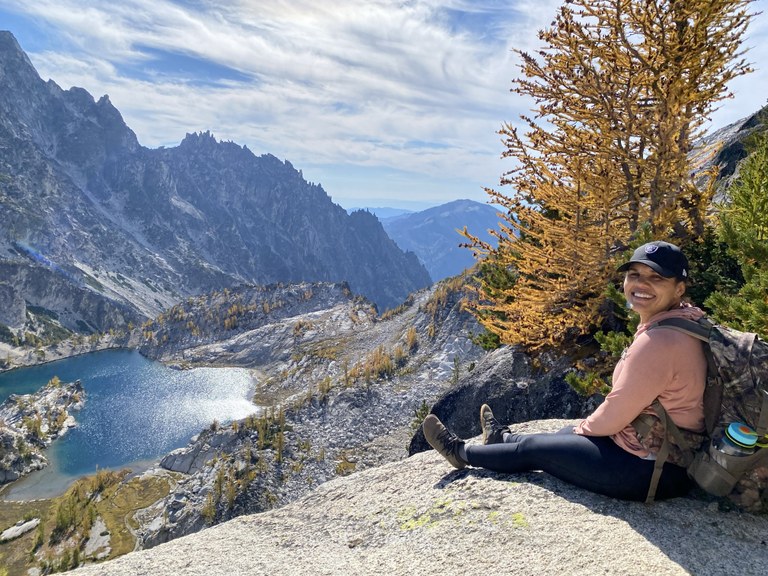
Rachel’s activism is fully intertwined with her connection to the Earth. Her commitment to the land has brought her to Standing Rock as a Water Protector, fighting a pipeline that would desecrate Tribal lands and endanger water supplies, and to lead protests that shut down banks that fund fossil fuel extraction. From experience, she knows that front-line work can be exhausting to mental health and has seen the power of time in nature to heal and reenergize activists like herself.
“I also believe that it will be Indigenous knowledge that helps bring balance back to our Earth, and as a Native woman, I get to bring a piece of that knowledge into the spaces I go to,” Rachel said.
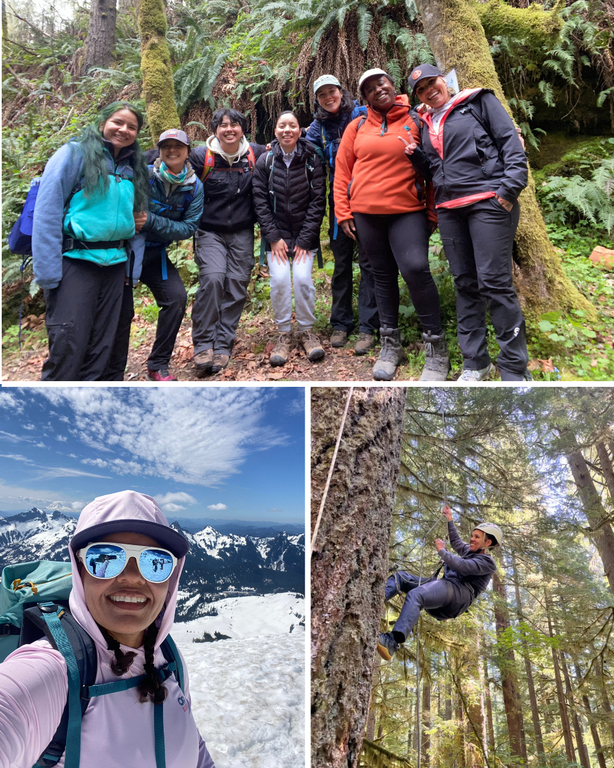
Clockwise from top: Rachel with members of WTA's Emerging Leaders Program, participating in Deep Roots Action Camp, and on a training hike to Camp Muir. Photos courtesy of Rachel Heaton.
Rachel loves to be on the land, even if just to sit in the cool mist near one of her favorite waterfalls. She wants other people to have that opportunity and to have a sense of stewardship. One of the ways she’s doing that is by preparing to climb Mount Rainier, known to her Tribe as təqʷubəʔ and also known by many names to different Tribes including Tahoma, Tacoma and Taquoba, for the 125th anniversary of the national park.
Last summer, she was a member of the first all-Native climb on that peak. But for Rachel, the goal of the summit comes second to the all-important connection to the mountain and to the land.
“The summit is just a bonus,” she said. “My big goal is to show people how to be better stewards. Our interactions with Mother Earth shouldn’t be transactional. We’re already in a sacred space.”
Rachel’s journey toward a climb of Tahoma began, in some ways, when she found out she was pregnant with her youngest child. She had older children, and having a new baby felt like starting over. The pregnancy was hard on her, and once her son was born, she wanted to be able to return to the gym. She’d been a competitive bodybuilder in the past.
“The gym was a place where I went to take care of myself,” she said. “But once he was born, I couldn’t just go to the gym whenever I wanted. I had a baby to take care of.”
So, she began to think about what she would normally do in the gym and how she could transition that to her time outdoors. She made a plan to get outside with her son and make that her workout.
“I’ll carry my baby and he’ll be my resistance and hiking will be my cardio,” Rachel said. “I started heading out to Tahoma, to be out there with my son. But there were no Native people out there, at least not from my community.”
When she realized this, she started to think about why that was and what she could do to encourage more Native people to spend time near the mountain. At first, her time outside had been personal — a way to care for her physical and mental health. But over time, she wanted to do more.
“I was trying to create visibility,” she said. “I was trying to show that Native people are here, we are in this space.”
Rachel organized group hikes to areas around the mountain, and she began dreaming about climbing. In 2022, she took a training trip with a group and, after a few days on the mountain, had to make the tough decision to go back. She was fit, but she wasn’t ready for all of the elements of being on the mountain. It was hard on her ego, but she also realized that her goal of increasing Native representation was much bigger than her.
She went and talked to Gordon Janow, one of the founders of Alpine Ascents. She told him why it was important to her to get out on the mountain and what it meant for Native people. He helped her get out on the mountain again later that year. That time, she had a stronger foundation and was able to increase her mountaineering skills and confidence.
Soon after that, Washington’s National Park Fund reached out to Rachel about the possibility of supporting an all-Native climb of Tahoma in 2023. She was excited at the prospect and also a bit overwhelmed.
“At that point, I did not know a single other Native who was climbing,” she said.
But she began reaching out to friends, family and people in her network and put together a team of all-Native climbers, including her significant other and her daughter. The group did a lot of training individually and also together, including a trip up to Camp Muir. That was a good learning experience — including about the risk of sunburn — and they were able to work out their gear systems and reduce their anxiety.
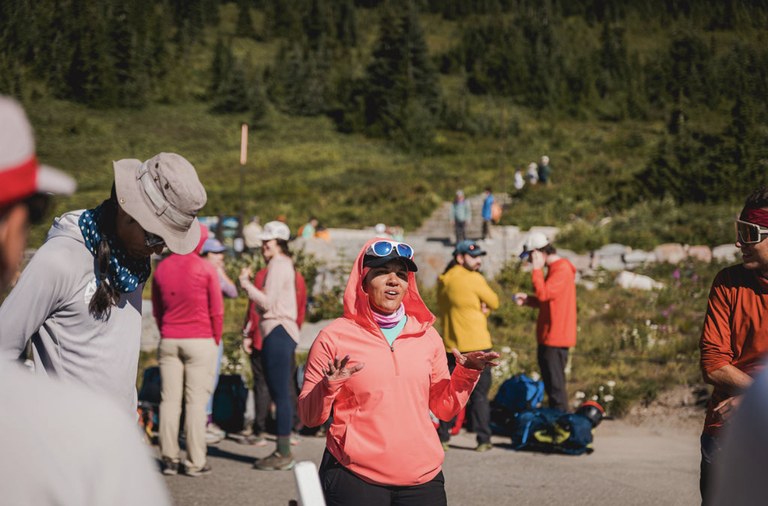
However, when it came time for the actual climb, conditions were far from ideal. International Mountain Guides (IMG), who would be guiding them, reached out. “They said, ‘We can do the climb, but we don’t think a summit is possible,’” Rachel said.
IMG offered to take them up Mount Baker, but that was a definite no for the group. The climb was about Tahoma — they did not have the same connection with Mount Baker.
“I talked to the team, and we all agreed to go up as far as we could,” she said.
The group knew they could do some crevasse exploring and some snow school training. When they first arrived, they endured hours of fog, which was cold and produced some anxiety. But they made it up to Camp Muir and, the next day, climbed up higher, nearly to Cathedral Gap. Rockfall that day, however, meant they couldn’t go farther.
That guide told the group, “When the mountain speaks, we’re supposed to listen. She will talk in subtle ways, but today she is shouting at us.”
While they didn’t summit, the experience was also magical. They were above the clouds and had Camp Muir to themselves.
“We didn’t make it to the summit, but that was never the goal,” Rachel said. “It was to be on the mountain, to be visible and to bring our knowledge and share that knowledge.”
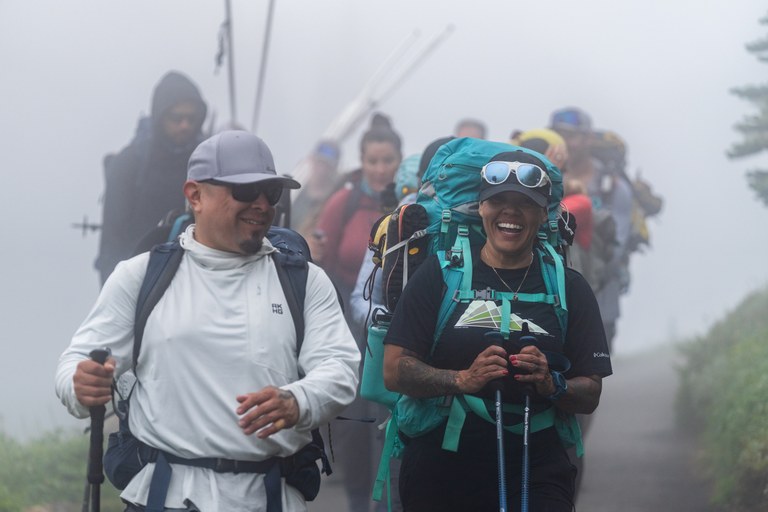
Rachel is eager to be out on the mountain again. But when she contemplates what’s ahead, she’s thinking beyond the next climb and to decisions being made today and what they’ll mean for generations to come. The national park has been around for 125 years, but what will it be like in another 125 years?
“We can have some uncomfortable conversations on the mountain, including about the climate crisis. The glaciers are receding, and our Tribe needs the rivers. We need to protect future generations. We have to teach about the land so we can go on. This is all much bigger than a climb; it’s for the future.”
For this climb, she’ll be heading up with Alpine Ascents, whose guides she has appreciated working with over the years.
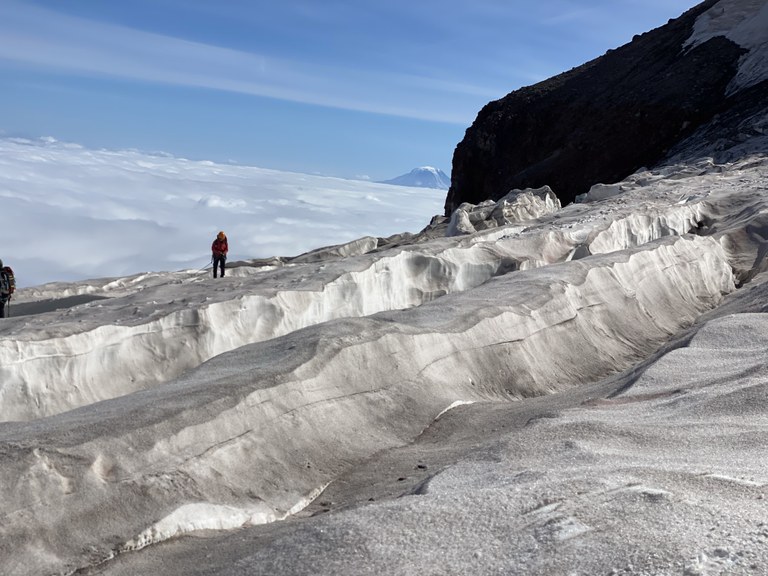
Rachel talks with Alpine Ascents guides about connections to the land and to the mountain and encourages them to help climbers see beyond the summit. She shares her own stories with the guides to help them understand that time on the mountain is sacred and that a connection to the land, plants and animals is vital — and encourages the guides to help their clients see that as well. Whether or not climbers summit, time on the mountain is profound and important.
Rachel’s hope is to remind folks that Native people are here and have always been here. She hopes her work encourages everyone to remember the immense importance of the natural world — to all of us.
“The creator gave me a purpose,” she said. “This is bigger than me.”